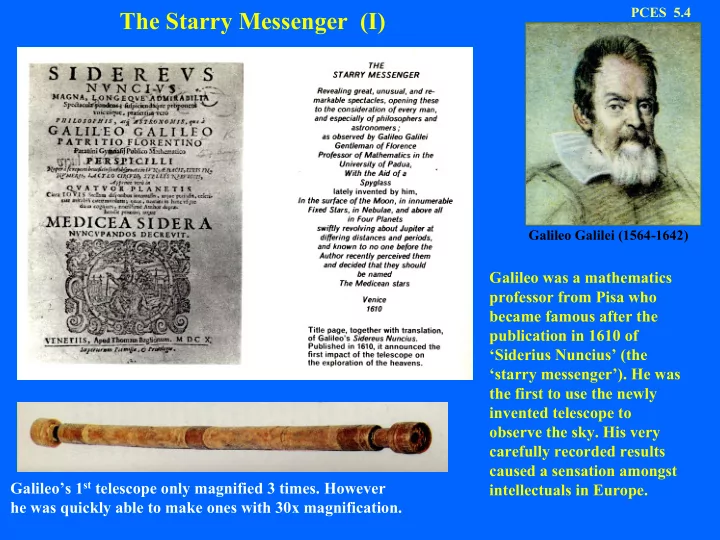

PCES 5.4 The Starry Messenger (I) Galileo Galilei (1564-1642) Galileo was a mathematics professor from Pisa who became famous after the publication in 1610 of ‘Siderius Nuncius’ (the ‘starry messenger’). He was the first to use the newly invented telescope to observe the sky. His very carefully recorded results caused a sensation amongst Galileo’s 1 st telescope only magnified 3 times. However intellectuals in Europe. he was quickly able to make ones with 30x magnification.
PCES 5.5 The Starry Messenger (II) About as powerful than today’s binoculars, his instruments allowed him to discern a multitude of stars beyond the visible. This was already rather troublesome for orthodox belief, since it indicated that the starry firmament was more extensive than previously believed. Giordano Bruno had been burnt at the stake by the inquisition (after a 7-yr trial) for promoting such ideas only 10 Yrs earlier. Galileo’s moon Worse was to come. The Heavenly bodies were held to be perfect by the church, so that the discovery of craters on the moon was a shock to Rome- and it lent further credibility to the ideas of Bruno. Galileo was happy to show the cardinals the view through his looking glass. The region of Orion’s belt & sword (LHS); and the Pleaides (RHS)
PCES 5.6 The Starry Messenger (III) By projecting the sun’s light onto paper, he found It was covered with spots which came and went, and moved with the sun’s rotation. When he turned his telescope on Jupiter the most shattering conclusion came- he found 4 stars associated with it, which moved from night to night in a way that could only be explained by assuming they were in orbit around the planet. At the time Galileo was content, with the example of Bruno in mind, to merely report his results- thereby avoiding Bruno’s fate. 1 st observation of Jupiter’s 4 major moons (the ‘Galilean satellites’) Galileo’s sun (with changing sunspots)
PCES 5.7 Galileo vs. the Inquisition (I) Although Galileo did not hide his opinions after the publication of his observations in 1610, he was not so foolish as to publish these. However in 1632, emboldened by the election of Urban VIII as Pope, he published his famous set of dialogues, in which the 2 world systems (Copernican and Aristotelian) are compared. The role of the Aristotelian was taken by Simplicius, who discussed the questions Salviati and Sagredo One of Galileo’s later Motion of the earth around telescopes the sun, according to Galileo (from the “dialogue”). The essential purpose of the dialogues was to demonstrate the superiority of the Copernican system in its description of the heavens, and also to highlight the deficiencies of the Aristotelian system in its discussion of dynamics. Thus the book (a rather long one) is written deliberately in the form of a philosophical dialogue, reminiscent of Socrates. The emphasis on the results of experimental science, as opposed to ‘first principle’ arguments, is a notable feature of this and earlier writings of Galileo.
PCES 5.8 Galileo vs the Inquisition (II) Galileo’s book sold out. 5 months later, Galileo was called before the Holy Office & tried by the Inquisition. Under threat (cf. G. Bruno) he was forced to recant, and kept under house arrest for the rest of his life. At the end of the 20 th century, 360 yrs later, the Church admitted its G. Bruno (1548-1600) mistake. Trial of Galileo (1632)
‘Discourses & Demonstrations concerning 2 New PCES 5.9 Sciences’, by Galileo Galilei ( Leiden, 1638) Galileo did not waste his time between 1633 and 1642 (when he died, by then blind for 4 yrs). With the help of a disciple (Viviani) he organized his work over a period of 40 yrs, and systematized it into a description of experimental philosophy and its results. This included a discussion of the results of his many experimental investigations of the dynamics of moving bodies, and the underlying principles he thought he had found. It is hard to appreciate now what a mammoth task he had set himself. It involved an emancipation from the idea that one attempted to understand the world starting from a priori principles- which required not only ideas but new tools (such as the clock shown at left). For Galileo’s dynamics, see the COURSE NOTES
Recommend
More recommend